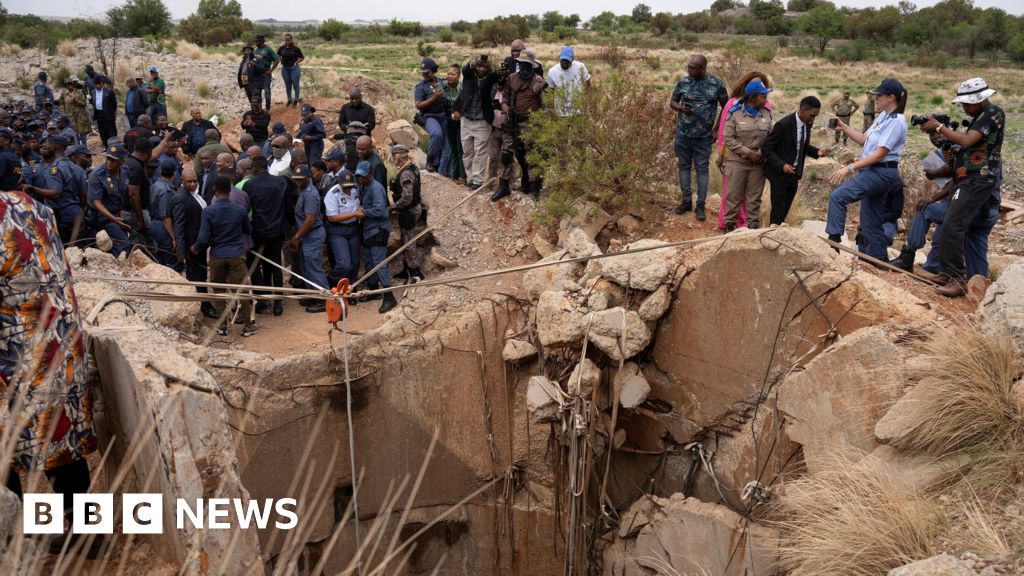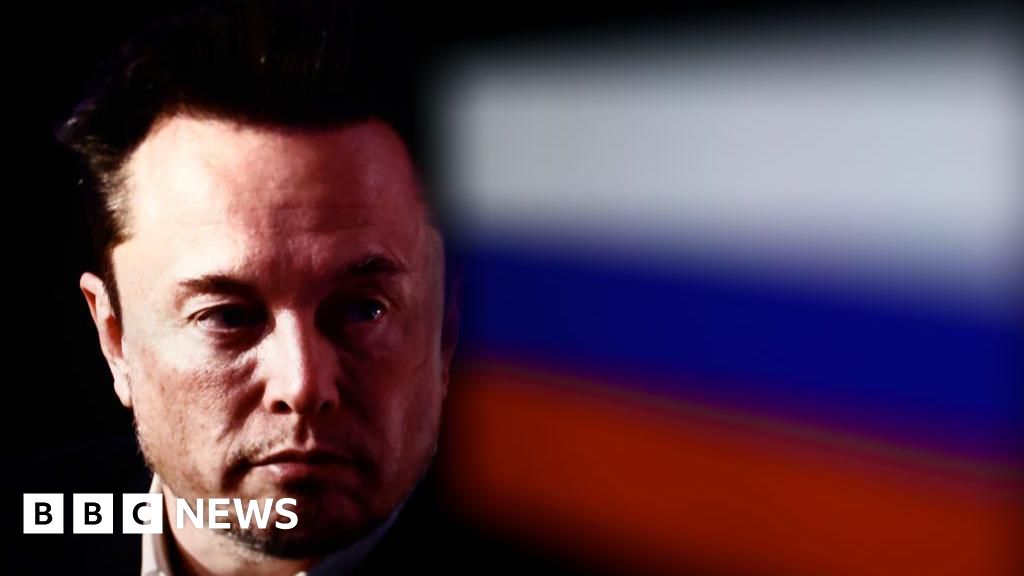ARTICLE AD BOX
By Ijeoma Ndukwe
BBC Business, Lagos
Image source, Christie’s Images Limited 2022
Image caption,Man in a Pool III was sold as a non-fungible token by Christie's last October
Paints, brushes and a canvas are the tools typically associated with visual art, but not for Osinachi.
He has become one Africa's foremost crypto-artists, using digital means to both create and sell his work.
Sitting at his dining table in his comfortable yet modest home in the Nigerian city of Lagos, Osinachi flips open a laptop and launches Microsoft Word. He stares at the screen poised with his stylus pen.
"There's a lot you can do on Word," he explains as he selects basic shapes in the programme, distorting and playing with their dimensions, filling them with vibrant colour and drawing with flourishes of his pen.
"What I've been doing over the years is to push myself to get deeper into it and see what I can achieve with this word processing tool."
Image source, Christie’s Images Limited 2022
Image caption,Man in a Pool I, like all of Osinachi's work, was created using Microsoft Word
Although digital art emerged decades ago, "crypto-art" is a phenomenon which has materialised more recently.
The term was coined as the blockchain technology used to buy and sell what are called non-fungible tokens (NFTs), which prove ownership, is the same as that used for cryptocurrencies.
"Only one person can say: 'I own this piece.' That is why digital art is valuable now," Osinachi says.
Furthermore, artists can ensure they receive a commission every time the work is sold on - a significant benefit not enjoyed in the traditional art world.
Last October, the 30 year old became the first crypto-artist from Africa to have his work sold by Christie's auction house in Europe.
His series of five NFTs, Different Shades of Water, first exhibited at the London edition of the 1:54 African art fair was inspired by the work of British artist David Hockney.
Image source, Christie’s Images Limited 2022
Image caption,Pool Day II is one of the pieces in the Different Shades of Water series
The images are a commentary on the prioritisation of work over wellbeing, according to Christie's, but they are also stunning to stare at, wrapping the viewer in a warm embrace.
"I think the first thing that draws them in is the beauty of the work," Osinachi says, reflecting on what makes his work popular.
"Then followed by whatever message I am conveying through the work. And beyond the message is the process. 'How did you make this?' When they discover I use Microsoft Word it's mind-blowing to a lot of them."
Image source, Christie’s Images Limited 2022
Image caption,Osinachi feels that the Christie's auction of Man In A Pool II and the other works brought him wider recognition
Prince Jacon Osinachi Igwe, to give his full name, was born and raised in Nigeria's south-eastern industrial town of Aba. When his father brought home a computer when he was 15, Osinachi began to experiment with creating digital images using Microsoft Word.
As he developed his work and tried to sell it through a traditional gallery he was met by rejection. However, in 2017 he found out he could sell NFTs using blockchain.
He recalls that in the early days, before the idea of NFTs had taken off, limited edition prints of his work would sell for as little as $60. At the Christie's auction in October his work went for more than $68,000.
In fact, using online marketplaces such as SuperRare, OpenSea and Nifty Gateway, Osinachi has sold NFTs for more but he says the acknowledgment of his work by the international auctioneer was invaluable.
"For me it's a validation of NFTs," he says. "Also, it's a big win for African digital artists [to see] that an African artist is actually doing this."
Isabel Millar, Associate Specialist of Christie's Post-War and Contemporary Art department, has observed how an initial divide between digital art collectors and traditional buyers is gradually fading.
"I think what's really interesting is that there's now been this crossover," Millar says.
The acceptance of Bitcoin as a means of payment at the auction is further evidence of this evolution.
Global attention was drawn to crypto-art when last year Christie's sold a digital collage by the little-known American artist Michael Winkelman, known professionally as Beeple, for $69m. It revealed the demand for this way of trading art.
Millar notes how empowering the medium is for artists, which could help African artists get around the gatekeepers. "It kind of bypasses a lot of the traditional art world structures of galleries and fairs," she explains.
However, this does not prevent such platforms embracing this innovation.
Screens of digital art were displayed at the recent Art X fair in Lagos
Lagos-based Art X, West Africa's most prominent international art fair, held its first exhibition dedicated to NFTs in November.
Multiple screens featuring vibrant digital imagery were mounted on a jet black wall within a sprawling marquee. It was curated by Osinachi and featured 10 artists from African countries including Nigeria, Morocco and Senegal.
Art X founder Tokini Peterside says she is excited about what she describes as an "NFT revolution".
"We realised that this was a fantastic way for… digital artists to monetise their practice," she says.
Peterside cites the ascent of 21-year-old digital artist, Anthony Azekwoh, also based in Lagos.
The young talent made around $40,000 from his NFT art series, The Deathless Collection, in 2021 with the NFT for The Red Man selling for $25,419.
Image source, Anthony Azekwoh
Image caption,The Red Man was created by artist Anthony Azekwoh
However, some cultural curators are sceptical of the idea that the platform democratises art and question the extent of the medium's transparency.
"It feels as though there are a bunch of [tech] bros fixing the prices," says one gallery owner who asks to remain unnamed, referring to the heavy involvement of technology entrepreneurs who traditionally patronise NFT art.
"Will [New York's] Museum of Modern Art become less relevant? No. The established institutions will remain important."
Image source, Ade Adekola
Image caption,This piece by Ade Adekola is called Bride 3 and is part of his Anthology of an African Wedding series
Crypto-art enthusiast Ade Adekola has been a digital artist for more than 20 years and has recently started to sell his work as NFTs.
He shows me his latest works on display at Gallery B57, his own space located in Victoria Island, an upmarket neighbourhood in Lagos. The artist explains that although NFTs are an exciting new opportunity, gatekeepers still exist.
"What makes you a winner in the NFT space is not your ability to create," Adekola says. "It's your ability to sell, and your ability to sell is based fundamentally on your ability to communicate."
But that opportunity for African artists to reach out to the rest of the world through NFT art marketplaces does offer them a chance to get a wider audience, according to Osinachi.
"The middlemen tend to decide who gets through and becomes a big artist. In the NFT space, the artist can decide to go and do their thing and make a name for themselves and make money from their work."

 2 years ago
33
2 years ago
33








 English (US)
English (US)